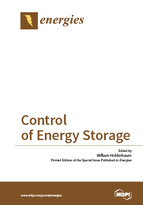Control of Energy Storage
A special issue of Energies (ISSN 1996-1073).
Deadline for manuscript submissions: closed (31 January 2016) | Viewed by 123421
Special Issue Editor
Interests: power management systems; control theory; hybrid dynamical systems; optimal control; Hamiltonian systems under Lie group; control and management of storage; wireless power transfer; remote monitoring and sensing
Special Issues, Collections and Topics in MDPI journals
Special Issue Information
Dear Colleagues,
Energy storage can provide numerous beneficial services and cost savings within the electricity grid, especially when facing future challenges like renewable and electric vehicle (EV) integration. Public bodies, private companies and individuals are deploying storage facilities for several purposes, including arbitrage, grid support, renewable generation, and demand-side management. Storage deployment can therefore yield benefits like reduced frequency fluctuation, better asset utilisation and more predictable power profiles. Such uses of energy storage can reduce the cost of energy, reduce the strain on the grid, reduce the environmental impact of energy use, and prepare the network for future challenges.
This Special Issue of Energies will explore the latest developments in the control of energy storage in support of the wider energy network, and will be focused on the control of storage rather than the storage technology itself. Specifically, this issue will encompass:
• Control of energy storage (e.g., for flywheels, batteries or supercapacitors)
• Energy storage systems for transport (e.g., for automotive, shipping and aircraft)
• Energy storage systems for grid support including use with ancillary services
• Intelligent coordination of storage elements in the grid both at micro (i.e., low voltage) and macro (i.e., high voltage) scales
• Monitoring, modelling and other performance assessment methodologies for the control of storage
• Explorations of the future of energy storage systems and associated control problems
We welcome papers based on primary leading research, as well as cutting-edge exemplars from industrial practice that can be used to encourage sustainable development and performance of control of energy storage systems.
Prof. Dr. William Holderbaum
Guest Editor
Manuscript Submission Information
Manuscripts should be submitted online at www.mdpi.com by registering and logging in to this website. Once you are registered, click here to go to the submission form. Manuscripts can be submitted until the deadline. All submissions that pass pre-check are peer-reviewed. Accepted papers will be published continuously in the journal (as soon as accepted) and will be listed together on the special issue website. Research articles, review articles as well as short communications are invited. For planned papers, a title and short abstract (about 100 words) can be sent to the Editorial Office for announcement on this website.
Submitted manuscripts should not have been published previously, nor be under consideration for publication elsewhere (except conference proceedings papers). All manuscripts are thoroughly refereed through a single-blind peer-review process. A guide for authors and other relevant information for submission of manuscripts is available on the Instructions for Authors page. Energies is an international peer-reviewed open access semimonthly journal published by MDPI.
Please visit the Instructions for Authors page before submitting a manuscript. The Article Processing Charge (APC) for publication in this open access journal is 2600 CHF (Swiss Francs). Submitted papers should be well formatted and use good English. Authors may use MDPI's English editing service prior to publication or during author revisions.
Keywords
- power management and control
- distribution network and transmission network
- storage in interconnected grid systems
- smart grid and optimal control for demand-side management






